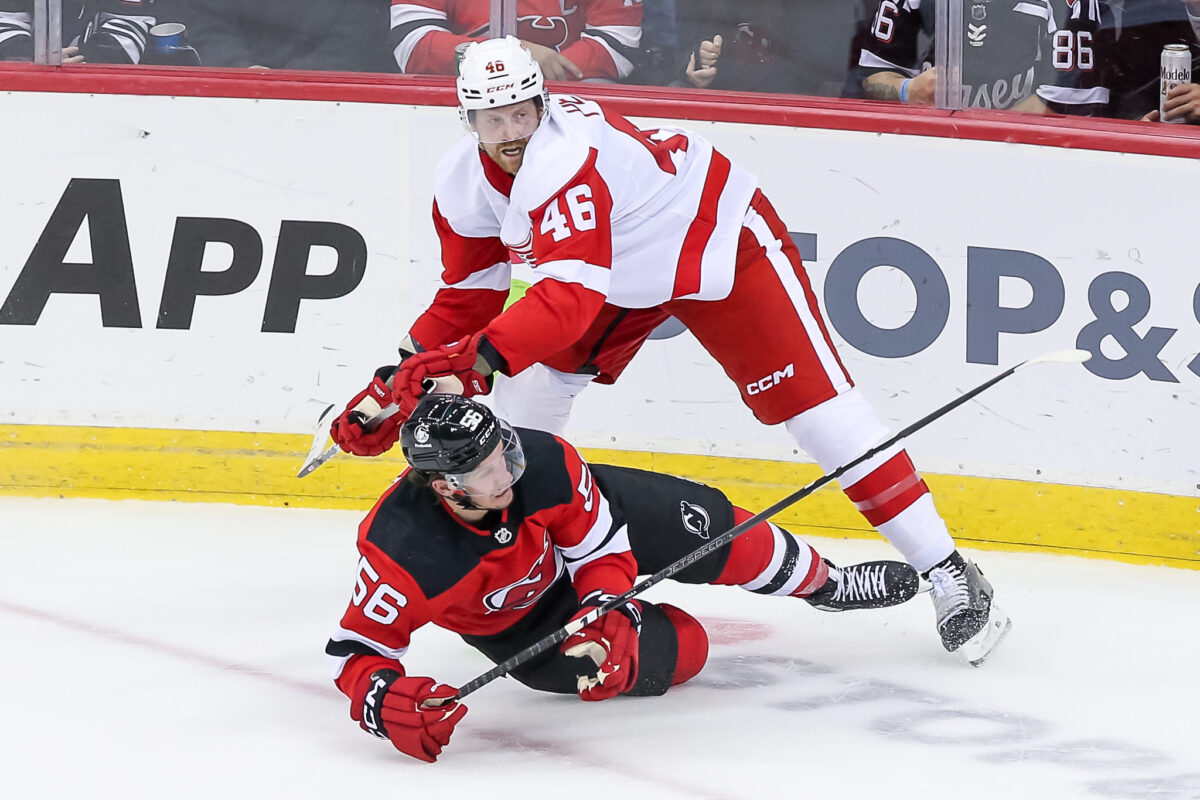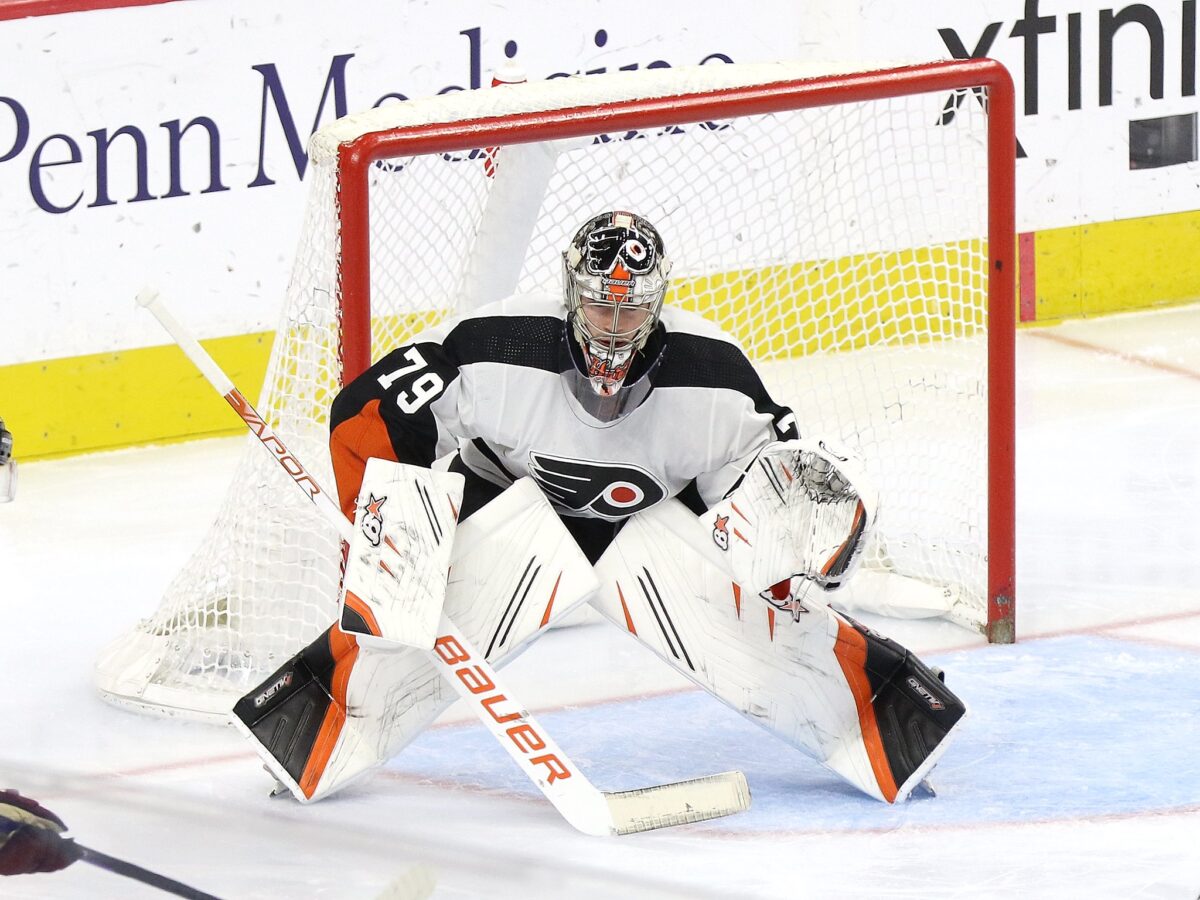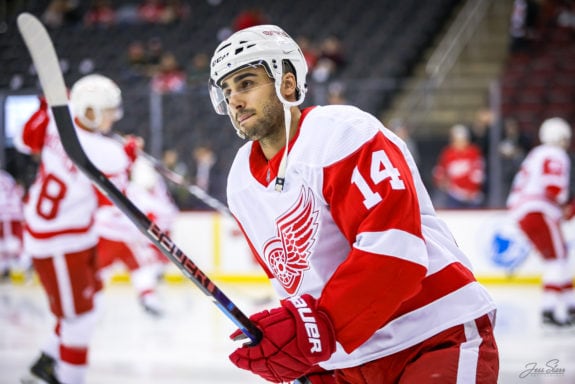With the Detroit Red Wings back in North America and set to face the New Jersey Devils on Wednesday night, I thought it would be a good time to empty the notebook and discuss a few early-season trends.
We’re 17 games into the 2023-24 campaign – about 20 percent of the way through. Detroit’s 8-6-3 record places them fifth in the Atlantic Division and ninth in the Eastern Conference.
It’s been a rough stretch for the Red Wings, going 1-2-2 in their last five games. Perhaps the NHL Global Series provided a wake-up call, though.
With that being said, let’s dive into some data, suggestions, and more.
Red Wings’ Use of 7 Defensemen
So far, the Red Wings have dressed 11 forwards and seven defensemen on three occasions this season. They’ve won all three contests, averaging 5.33 goals per game.
Why is this?

Two reasons come to mind. First, the use of seven defensemen allows the Red Wings to be more selective in their deployment. If one or two blueliners don’t have their A-game that night, then they won’t see the ice much.
For example, Detroit can deploy the top two pairs for 75 percent of the game, leaving the third pair to play the remaining 25 percent. You can either rotate through the three defensemen or have one constant No. 5 rearguard with the other two alternating. In the latter scenario, the worst two defensemen are only playing 7-9 minutes, as opposed to 12-15 when six blueliners dress. And since they are on the ice so little, Detroit’s coaching staff can shelter them appropriately.
The other factor in play here is that, with 11 forwards, the top players are on the ice more often. The flip side is that the “fourth”-line forwards are on the ice less.
Klim Kostin saw five minutes of action in two of the 11 forwards/7 defensemen games. (He was injured for the other game.) Likewise, Austin Czarnik saw six and seven minutes, respectively, in the games he suited up for.

With Kostin, Czarnik, and Christian Fischer on the bench for most of these games, the Red Wings rolled three forward lines, giving the likes of Dylan Larkin, Lucas Raymond, Alex DeBrincat, J.T. Compher, and Andrew Copp additional ice time.
The result: Detroit’s top players produced and they won. Perhaps the Red Wings should dress 11 forwards and seven defensemen more often.
Detroit’s Next Big Trade: A Goalie?
THW colleague Devin Little recently noted that the Red Wings have a big problem in net, and I wholeheartedly agree. Ville Husso has not stepped up to the plate as many of us hoped he would – he just hasn’t shown that he can be a bonafide starting goalie.
This makes me wonder if Steve Yzerman’s next big trade is for a goalie. Think the magnitude of the Alex DeBrincat deal.
Carter Hart of the Philadelphia Flyers comes to mind. The Flyers are in the midst of a rebuild, and Hart is one of their top trade chips. He’s 25 and will be a restricted free agent this summer.

Do the Flyers want to sign Hart long term knowing that they’ll be rebuilding during his prime? It might make more sense to deal him.
John Gibson and the Anaheim Ducks are in a similar spot. The 30-year-old netminder is signed through 2027 and is splitting time with top prospect Lukas Dostal.
Gibson could prove especially valuable. His age and contract position him nicely to serve as a bridge until Sebastian Cossa is ready to take over starting duties at the NHL level. In addition, as a former top prospect and young starting goalie, he could be a great mentor for Cossa.
Both Hart and Gibson would be upgrades over Husso, but neither are likely to be dealt in-season. If Husso continues to struggle, Yzerman could make a move this offseason to bring stability to the position.
Detroit’s Empty Net Woes
An odd trend early in the 2023-24 season has been Detroit’s inability to convert with an extra attacker. Last Friday’s game against the Toronto Maple Leafs was the latest example of this.
In all, the Red Wings have pulled their goalie six times. They’ve only scored one goal with the extra attacker, and it came after allowing an empty netter. In total, Detroit has allowed four empty net goals this season.

Given the fact that Detroit’s 49 seconds of empty net time per game played is seventh-most in the league, improving their 6-on-5 output should be a priority.
So what is it? A personnel issue? Strategy? Something else?
They’re maintaining possession on the outside well and putting a sufficient amount of pucks on net. But from my perspective, the main issues seem to be puck retrieval and generating quality chances. When the Red Wings lose the puck, they seem to lose it for good. Forechecking in the offensive zone and backchecking toward their empty net could stand to be better.
As for quality chances, here are Detroit’s scoring chances-for per 60 (SCF/60) rankings among the 152 skaters who have played at least five minutes with an empty net this season:
- Lucas Raymond – 89.5 (46th)
- Alex DeBrincat – 69.36 (73rd)
- Moritz Seider – 59.14 (95th)
- Shayne Gostisbehere – 57.6 (100th)
- Dylan Larkin – 56.34 (105th)
- David Perron – 53.03 (112th)
Not enough quality chances are getting through. Detroit’s strategy and execution need to be worked on to improve this and the puck retrieval issue.
Final Word
The Red Wings are within striking distance of a playoff spot, but there’s work to be done. Better goaltending, better team defense, and stronger extra attacker play can help them close the gap.
Deploying 11 forwards and seven defensemen could help. It’s been a successful strategy so far. Plus, it could give the Red Wings an opportunity to get Simon Edvinsson some NHL ice time.
Stats courtesy of Natural Stat Trick and NHL.com.
